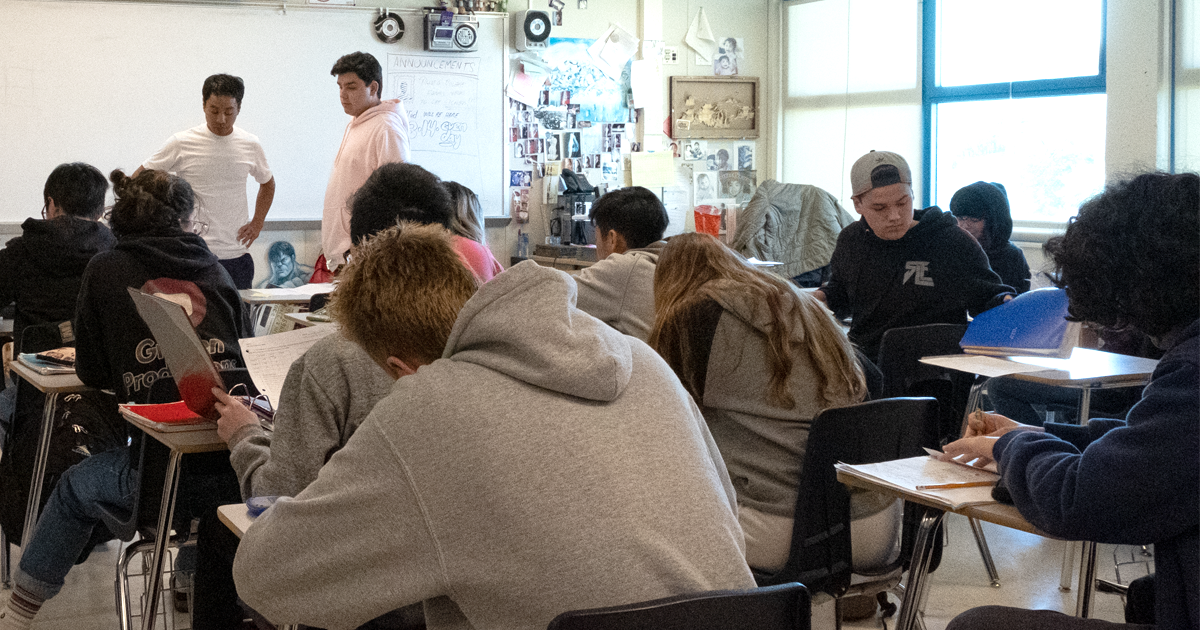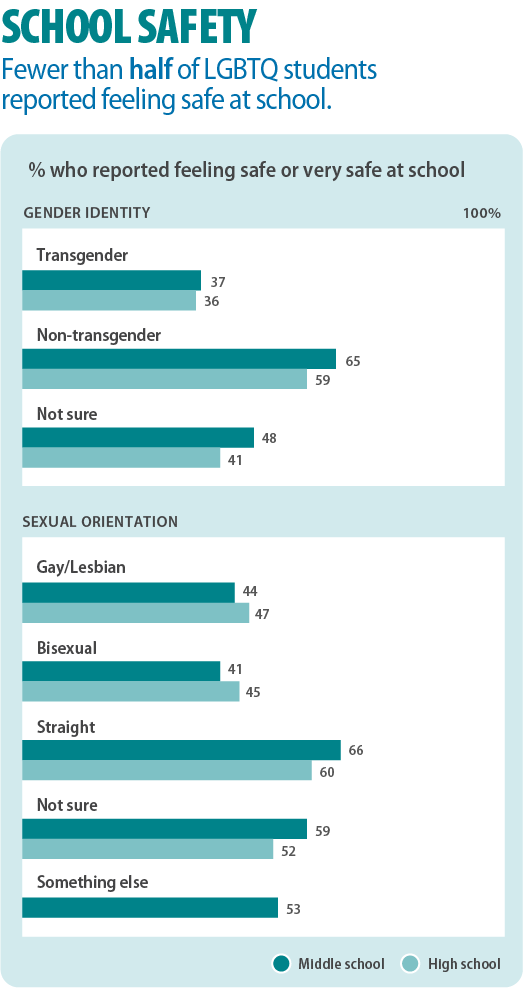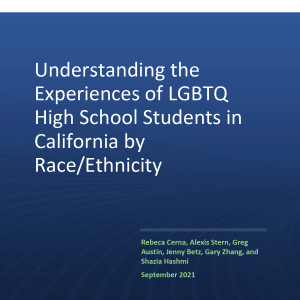Shedding Light on the Experiences of LGBTQ Students: Sobering Data and Reasons for Hope
Posted on

Lesbian, gay, bisexual, transgender, queer, and questioning (LGBTQ) students have historically been invisible, underserved, or misunderstood — or all three, says Jenny Betz, a School Climate Specialist at WestEd. “If you don’t feel accepted, have to hide something fundamental about who you are, or are scared at every step, you obviously won’t be fully present and immersed in learning.”
To shed light on LGBTQ students’ experiences in school, WestEd researchers analyzed two years of results from the California Healthy Kids Survey, which provides arguably more data on LGBTQ youth than any other source in the nation. The data reflect survey responses from approximately 800,000 students in grades 7, 9, and 11 at more than 2,700 secondary schools. The resulting study, Understanding the Experiences of LGBTQ Students in California, revealed both sobering and encouraging results.
The study found that LGBTQ secondary students were at higher risk for bullying, chronic sadness, and thoughts of suicide, as well as poorer learning engagement and academic performance, compared to their straight and non-transgender peers. LGBTQ students also reported receiving substantially fewer social and developmental supports from teachers. But the study’s analysis suggests that if LGBTQ students experienced the same levels of support and safety at school as non-transgender and straight students, disparities would disappear or greatly diminish.
Disheartening findings
Among those surveyed, almost 14 percent of both middle and high school students identified as having a sexual orientation other than straight (about 111,000 students), and about 3 percent identified as someone whose gender identity did not correspond with their birth sex (nearly 24,000 students).
To create a more complete, nuanced picture of these students, WestEd deliberately disaggregated the data on sexual orientation and gender identity. “Because of confusion about the differences between sexual orientation and gender identity, we initially even considered writing two separate reports,” says Rebeca Cerna, Area Director at WestEd and co-author of the report.
The study’s key findings include the following:
- Transgender, gay or lesbian, and bisexual students were less likely than their non-transgender and straight peers to report the presence of key school supports, to be engaged in school, or to report a high grade point average.
- Fewer than half of transgender, gay or lesbian, and bisexual students reported feeling safe at school.
- Transgender, gay or lesbian, and bisexual students were twice or more as likely to report that they had experienced bullying or harassment and were in fear of physical violence.
- Transgender and bisexual students were most likely to experience chronic sadness and to consider suicide.
 “Sadly, these findings were not surprising,” says Betz. “What jumps out is how consistent the study’s results are with the data collected across the country over the last two to three decades.”
“Sadly, these findings were not surprising,” says Betz. “What jumps out is how consistent the study’s results are with the data collected across the country over the last two to three decades.”
Whether someone directly teases or taunts them, or they simply hear a constant barrage of negative comments — “that’s so gay” or “don’t be a fag” — these students often receive the message that something is wrong with them, says Betz, and may begin to feel that they are in danger. Adding insult to injury, says Betz, is often not hearing any positive messages in the classroom about their gender or sexual identity. Worse still, is feeling victimized by staff on campus. “Transgender and nonbinary students, for example, still face obstacles from some administrators about using a bathroom or locker room that aligns with their gender,” says Betz.
A silver lining in the data
For a long time, says Betz, there has been an unsubstantiated idea that something is inherently wrong with LGBTQ students, leading to poorer relationships and academic outcomes in schools. Instead, this study’s findings suggest that a perceived lack of support is the main culprit — and that schools have the power to make a big difference.
“WestEd’s study was able to show that if these students had the same school supports as their peers — the same access to high expectations, the same positive relationships in schools, the same experiences in terms of lower victimization rates, for example — their outcomes would be dramatically better,” says Betz.
In fact, the study found that if transgender, gay or lesbian, and bisexual students experienced similar levels of support and safety as other students, disparities in their mental health, academic motivation, and academic performance in school would shrink by half. For transgender students, disparities in school connectedness would disappear completely and for lesbian, gay, and bisexual students, disparities in school connectedness would lessen by 90 to 100 percent.
If these students had the same school supports as their peers, their outcomes would be dramatically better.
“Sometimes school might be the only sanctuary for a kid in the otherwise hostile world they find themselves in — whether it’s their home, their faith community, or their neighborhood,” says Joel Baum, Senior Director of Professional Development for Gender Spectrum, a nonprofit focused on creating gender-inclusive environments for children and teens.
What schools can do
Laws can help, but on their own they’re not enough, says Betz: “California has some of the most inclusive laws and education codes, and yet we still have such high numbers of students without access to safe and inclusive learning environments.”
Before joining WestEd, Betz trained thousands of educators on how to support LGBTQ students. “Some teachers would say, ‘It’s obvious I love all my students,’” recalls Betz. “But if you want to be a true ally, you have to make your support visible.”
Cerna agrees, adding that students are always watching and need to see more modeling of safety. She recounted an experience her daughter, an eighth grader, recently had. A student in her daughter’s history class told the teacher that the trans and LGBTQ flags in his classroom were making him uncomfortable. “My daughter waited to see how the teacher would respond. He told the student, ‘In my classroom, I’m trying to provide a safe environment for all my students. If you’re not comfortable, I’m happy to set up a meeting to discuss your concerns.’”
In addition to being verbally and visually demonstrative, educators can refer students to other supports as needed, says Betz. “If educators don’t know how to navigate the students’ questions, they can identify other resources and say, ‘Thank you for coming to me with this — I know someone who can help.’”
Gender Spectrum, which has reached educators working with more than 3.2 million children, suggests four different entry points. These entry points create a fabric of inclusion, not only around gender, but other aspects of identity as well, says Baum, who was a panelist in the WestEd-hosted webinar Evidence-Based Support for LGBTQ Middle and High School Students and who has a background as a middle school science teacher, school principal, and district administrator.
- Internal. “Be committed to learning more about gender, including reflecting on your own experiences,” says Baum, “and be sure not to conflate it with sexual identity.” When we do confuse them, gendered spaces such as school bathrooms get sexualized even though they have nothing to do with sex, he says.
- Interpersonal. “Become very cognizant of language,” says Baum. “Are you unintentionally promoting a limited, binary notion of gender in your everyday interactions — maybe praising girls for appearance and boys for accomplishment, or not challenging phrases such as ‘throw like a girl’ or ‘man up’?”
- Instructional. “What are you teaching or perhaps not teaching about gender?” If you’re an English instructor, for example, you might occasionally use a writing prompt related to gender or sexual orientation.
- Institutional. Consider adding images in the classroom such as photos of male nurses or women firefighters, or a sign such as, “All Genders Welcome.”
“It’s not all about the grand gesture — a transgender awareness day or a big assembly where a member of the LGBTQ community talks to all the students,” says Baum.” It’s lots of things in ways large and small that communicate an awareness, an accounting for, and a celebration of the unique gender of every young person.”
Finally, while this work is life-saving for some, Baum believes it is life-affirming for all — reinforcing that none of us should be limited by our gender or sexual orientation.
Still more to learn
Because LGBTQ represents such a diverse group of people, says Cerna, there is still more to explore in the data. For example, students who were unsure about their sexual orientation or gender articulated higher levels of risk than LGBT students. And, along with students who identified as transgender, bisexual students were found to experience greater sadness and suicide contemplation. What’s the story behind those data, wonders Cerna.
“Focus groups and conversations with these youth might unearth more,” says Cerna, “so we can continue to figure out ways to provide them better support in our schools and communities.”
For more information about WestEd’s research on LGBTQ students, contact Rebeca Cerna at 562.799.5159 or rcerna@wested.org or Jenny Betz at 510.302.4370 or jbetz@wested.org.
Understanding the Experience of LGBTQ Students in California was supported by a grant from The California Endowment.

